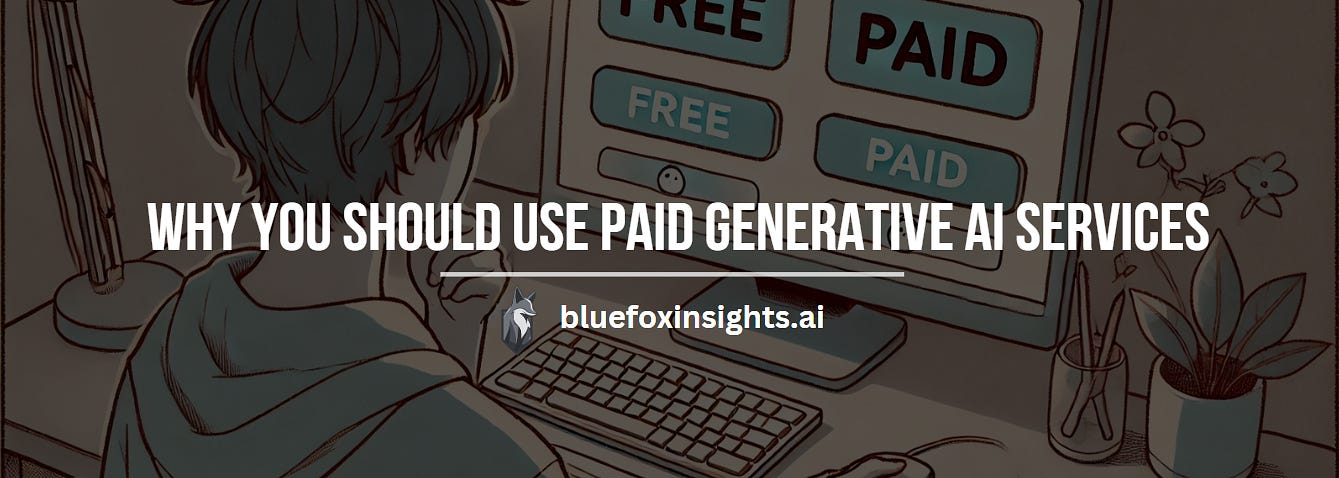Start Using AI Now - 2. Why You Should Use Paid Generative AI Services, Not the Free Versions
Generative AI (GenAI) is transforming industries, creating incredible opportunities for businesses to innovate and automate. However, with a landscape split between free and paid versions, many businesses and individuals find themselves questioning which option is best. Here’s a look into why using paid GenAI services isn’t just a matter of getting a premium experience—it’s a matter of protecting your data, securing your information, and optimizing the benefits of GenAI for real-world application.
Understanding How Generative AI Works
In my course , I explain that GenAI typically operates through two core components:
Transformers: These models generate responses by analyzing a vast “snapshot” of the Internet, creating a foundation for predicting text, generating images, and even producing videos. This snapshot serves as the initial knowledge base.
Reinforcement Learning from Human Feedback (RLHF): Here, GenAI continually improves by learning from each interaction, which allows it to better meet user needs over time. When you’re using a free version, this ongoing learning process often involves training the GenAI on your specific data.
When you’re using a free GenAI service, your interaction data is likely being used to train and improve the system. This can mean your information might be less private than you think. Paid versions, by contrast, typically come with stricter data-handling policies, ensuring your data stays confidential and isn’t used in training processes. So, the first reason to go with paid GenAI tools? Data privacy.
Protecting Data from New AI Vulnerabilities
Beyond data privacy, data security is a growing concern as hackers identify innovative ways to exploit AI interactions. Hackers can now embed certain phrases or instructions within documents you upload to GenAI tools, manipulating these tools to send sensitive conversation data to outside sources. This strategy, known as “prompt injection,” has been making headlines as a cutting-edge security risk.
For example, recent cybersecurity news reports that hackers have designed prompts hidden within documents. When unsuspecting users upload these documents to a GenAI, the embedded prompt sends selected data back to the hacker’s network. This level of access poses a serious risk to companies using free GenAI tools. Paid GenAI versions, on the other hand, are generally more secure and regularly updated to counter these threats.
Added Value in Paid GenAI Features
One additional benefit of paid GenAI services is access to expanded features that often aren’t available in free versions. Advanced tools, higher data limits, integration options, and specialized functions make paid GenAI a much more versatile option. However, while these expanded features certainly add value, in my opinion, data security and privacy remain the most compelling reasons to invest in a paid service.
Why Paid GenAI Should Be a Policy Standard
With these concerns in mind, businesses should consider a clear policy that restricts employees from using free GenAI tools for work-related tasks. Free tools pose unnecessary risks, exposing sensitive company data to the training processes or the vulnerabilities mentioned above. Implementing a “paid-only” policy can protect company data and also ensures employees are using tools with the highest security standards.
Parents might also consider setting aside a GenAI budget for family use. Children and teens are increasingly using GenAI for schoolwork or entertainment, and every interaction feeds into the AI’s learning process. By using a paid tool, parents can help keep family data private and secure.
A Lesson in Digital Caution: Why Privacy Matters
About a decade ago, when my wife and I had our first child, I asked her not to share any pictures of our child online—not on social media, not in family group chats, nowhere. She asked why, and I told her that based on everything I was studying in grad school at the time, I knew that data was going to be used in ways we couldn’t fully foresee. And I was already seeing how personal data could end up in places that would be suboptimal for us.
Now, looking at how personal data is increasingly integrated into AI models, I see just how warranted that concern was. But this isn’t a reason to avoid these tools or retreat from innovation. Instead, it’s a call to get educated, make informed choices, and push ahead with clarity and confidence. Through the series, my goal is to help everyone harness the power of GenAI wisely—so let’s be proactive, use the right tools, and make smart decisions that will help us succeed in this new AI-driven world.
Author’s Note:
The ideas and content in these articles come directly from me, but I do engage in conversations with AI to get feedback on my thoughts before producing the final pieces. While AI helps me refine the structure and flow, all the insights and ideas are my own. These articles are NOT robot-generated.



